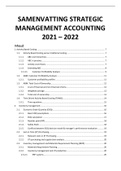Summary
Summary Strategic Management Accounting Master Business Sciences KU Leuven ()
- Course
- Institution
- Book
Full, detailed, structured summary of the Strategic Management Accounting course. Summary includes all seen slides + notes and additions from the handbook. The guest lectures are not included in the summary. Prof: M. Cools (Campus Carolus, Antwerp). Don't hesitate to leave a review! :)
[Show more]




